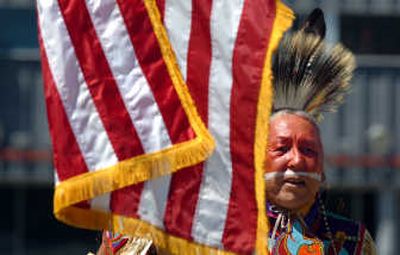Fry bread helps feed tradition

Fry bread is a powwow tradition just like the dancing, drumming and singing.
To many, the simple fried flatbread feeds the soul just like the Coeur d’Alene Tribe’s annual Julyamsh powwow gathering – a tradition in which the tribe invites other Indian tribes to come celebrate life and good happenings.
Frank Carson, an Otoe tribal member from Stillwater, Okla., ate enough of the puffy golden dough Saturday morning to win $100 and tie for the title of the 2007 Julyamsh fry bread eating champion. He doubts he will put his stomach through the competition again.
“I had to go throw up, but don’t tell anyone,” Carson said with a big belly laugh 20 minutes after tying for the championship. Luckily for Carson and the other winner, the judge let the men – both tall with proud bellies full of 11 pieces of thick, greasy bread – split the $200 cash prize instead of forcing a tie-breaker.
Of his strategy, Carson said: “Slow and steady wins the race.”
It was his first contest. He signed up Friday, and the only preparation he made was to skip breakfast Saturday, opting for just a little coffee and orange juice to grease his gullet.
To help support an Oklahoma relative, Rez Dog Clothing Co. “sponsored” Carson by giving him a bright-blue T-shirt that read “Frybread Power” to wear in the competition.
“He paced himself, and that’s what did it,” said Kylor DeHaas, a worker for the T-shirt company. “Half the people were just stuffing and gagging.”
The dozen or so contestants, mostly men, stood at folding tables in the grassy arena before the main horse parade and grand entry began. The stands hadn’t yet filled with the hundreds of people who arrived to see the dancers and their regalia of leather, feathers, beads and bells.
The only dancing the fry bread eaters did was to occasionally gulp bottled water, wipe sweaty foreheads or gently pat their tummies – almost as if to urge the gastric organ to cooperate and open larger.
“You guys remember, keep it down,” the announcer said as the contestants chewed. “No back flow.”
A young woman in the stands, braiding another woman’s hair, shook her head.
“I can’t even eat one piece,” she said.
A few feet away, food vendors from across the country sold variations of the bread for $3 or $4 apiece. It’s a few dollars more if customers order taco-style with beans, meat, cheese, lettuce and onion. Some sold hamburger patties wrapped in fry bread instead of buns.
At the “Navajo Handmade” stand, Lorraine Nakai – a Navajo from Arizona – stepped from behind a canvas wall with a raw, thin piece of floury dough draping from her hands when a visit with the main fry bread cook was requested.
She said she learned how to make the bread from her grandmother. Her 3-year-old granddaughter, who sat on an ice chest watching the customers, knows how to mix the flour, baking powder and salt.
“It’s a very important part of our heritage,” Nakai said, returning behind the curtain to slip the dough into hot shortening.
She gave up her recipe: Mix 8 cups flour, 2 tablespoons baking powder, a dash of salt and enough water to mix by hand. Fry the dough in shortening.
“It’s not fair using a rolling pen,” Nakai said. “You have to use your hands.”
And if you want real puffy bread, put some shortening and powdered milk in the mix.
Although fry bread is considered a traditional Indian food, Nakai said it likely came from the Spaniards, perhaps originating from the tortilla.
It’s thought the Navajos started making the bread when they went on the “Long Walk” starting in 1863. The Navajo were forced from their traditional lands in what is now Arizona to Fort Sumner, N.M. Nakai said they were only given lard – usually rotten – and flour as rations.
The bread became part of the culture and now is a popular part of any powwow.
“This is a good time for people to try it,” Nakai said.
As for Carson, he’s done eating fry bread.
At least for a day.